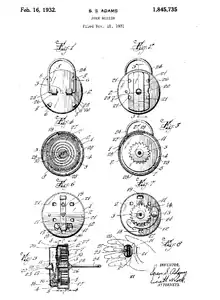Joy buzzer
A joy buzzer (also called a hand buzzer) is a practical joke device that consists of a coiled spring inside a disc worn in the palm of the hand. When the wearer shakes hands with another person, a button on the disc releases the spring, which rapidly unwinds creating a vibration that feels somewhat like an electric shock to someone not expecting it.[1]

History
The joy buzzer was invented in 1928 by Soren Sorensen Adams of the S.S. Adams Co.[2] It was modeled after another product, The Zapper, which was similar to the joy buzzer, but did not have a very effective buzz and contained a button that had a blunt point which would hurt the person whose hand was shaken.
Adams brought a rather large prototype of his newly designed buzzer to Dresden, Germany, where a machinist created the tools that would make the parts for a new palm-sized Joy Buzzer. In 1932, the item received U.S. Patent 1,845,735 from the U.S. Patent Office. The instant success of the new item allowed Adams to move to a new building and increase the size of his company. Adams continued to send royalty payments to the tool and die maker until 1934, when the payments were returned.
In 1987, Sam Adams' son, Joseph "Bud" Adams, redesigned the mechanism for great durability and a louder buzz, and marketed it as the Super Joy Buzzer.
A common misconception—primarily due to false advertising by the makers and sellers of the device—is that the joy buzzer actually delivers an electric shock, and many stylized villains in fiction (e.g., Batman's nemesis The Joker) employ "lethally powerful" joy buzzers as weapons. An example is in Walt Disney's Mickey Mouse cartoon film Mickey's Rival (1936), wherein Mickey Mouse's hands are shocked by Mortimer Mouse's trousers. Another example is in the SpongeBob SquarePants episode "Pranks a Lot" (2004-10-11, S03E20b), wherein Patrick Star's hand is shocked by a joy buzzer, and in The Simpsons episode "Homie the Clown" (1995-02-12, S06E15), where Homer Simpson is shocked with it multiple times by Krusty the Clown to the point where he is tortured by it. However, a shocking pen does generate a mild electric shock when a victim presses the button on top; the pen can be turned to make it release the point.
See also
References
- Soule, Gardner (January 1955). "Fun's Henry Ford is Still Inventing". Popular Science. 166 (1): 123. Retrieved 18 December 2018.
- Mellina, Kate (2015-09-20). "Weird NJ: Magic tricks churned out at Shore". Asbury Park Press. Retrieved 2018-12-18.
